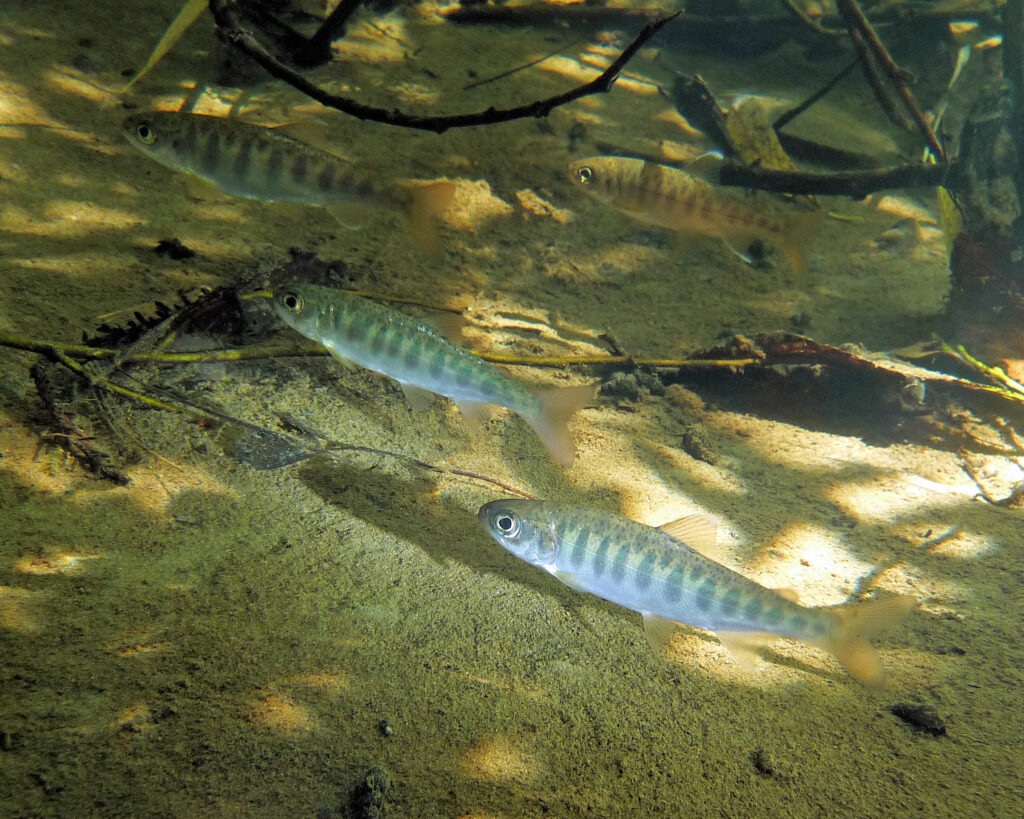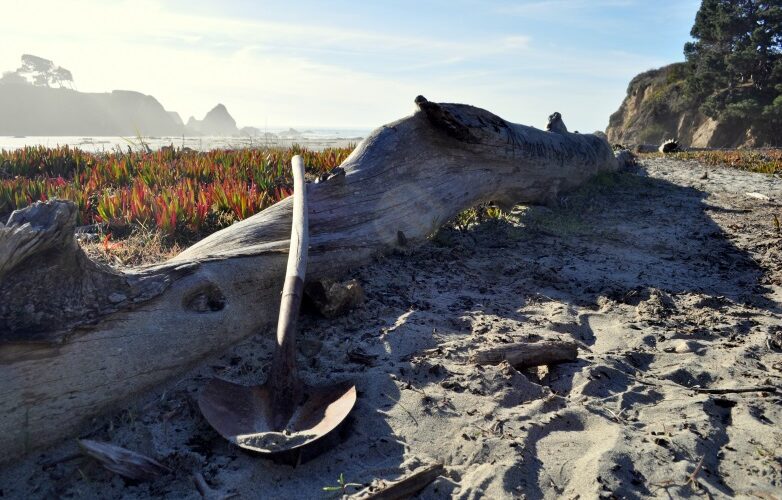Bear Gulch Habitat Enhancement
“Salmon are so emblematic of the Pacific Northwest and this part of California. Their significance transcends deep back into native cultures. I don’t know if project crew members realize they are part of this legacy, but it’s symbolic in a way, trying to restore not just salmon but the lifeblood of the land.”
– Khalil Laltoo, MLT Intern
“Bear Gulch is an incredibly beautiful area, a very small valley with mossy, fern-covered walls and a high tree canopy that allows light to soak through the trees in a magical way,” says Mia Sloane, a Mendocino Land Trust habitat restoration intern for the summer. On a recent day when she and other members of the MLT team visited Bear Gulch there was a trickle of water flowing through the creek. Before long, rains will increase the flow of the small stream. And when flows return, for the first time in a long while deep, habitat-rich pools will form and become ready to host future generations of salmon.

The Land Trust has a long history of making habitat enhancement happen. Since 2013, MLT has managed dam removal and culvert replacement projects that have opened 17 miles of previously inaccessible streams to spawning salmon. Additionally, MLT has been involved in the decommissioning and restoration of seven miles of old forest roads to reduce sediment runoff into salmon-bearing streams, and enhanced six miles of stream habitat by managing large woody debris projects. This summer, another stream enhancement project is in the works at Bear Gulch near the South Fork Noyo River in Jackson Demonstration State Forest.
Khalil Laltoo, an MLT summer intern from Reed College, details the adventures on their trip to visit the project site in summer, 2022: “We turned onto this unmarked forest road and parked near a little proto-trail and began trekking into this magical, wild forest. There was practically no indication that human activity was taking place within.” As MLT staff made their way to the site they had to cross the gulch four times, each time walking above the gulch on mossy logs. “You can’t help but feel childlike joy when doing that,” says Khalil. Mia adds, “It boggles my mind that logging trucks used to drive over these ’Humboldt Crossings.’ It was nerve-wracking enough crossing the logs on foot, I can’t imagine it in a truck.”

The long history of logging in the area turned previously vibrant creeks like this one into gulches full of slash and debris. The existing salmon populations went into a steep decline due to disturbance and lack of safe habitat. About 50 years ago, ecologists began trying to rectify the damage done by logging. They did this by removing all the debris from streams and creeks. The result was straight, fast-running clear streams that may have looked nice to the human eye, but they were entirely inhospitable for salmonids, especially for their young, and populations continued to drop.
Thankfully, the science around stream restoration has greatly improved, and ecologists today recognize that salmon need stream areas with slow water flows, deep pools and just the right amount of wood in the stream. Today, specialized biologists with titles like “Fisheries Habitat Specialist” carefully design custom structures that can be made of existing downed trees and create ideal habitats for salmon to rest and lay eggs. These areas also provide optimal conditions for young salmon and trout to develop.
This project is funded by a $200,000 grant from the California Department of Fish and Wildlife that was awarded to the Land Trust in 2021. MLT Director of Stewardship, Nicolet Houtz worked to complete permitting requirements and consulted with various organizations and specialists to plan the project. A California Conservation Corps Fisheries Habitat Specialists team evaluated the best places to form pools and provided plans and diagrams showing the appropriate size of logs to use and how they should be bolted together.
The physical work is completed by crews from the California Conservation Corps (CCC), an organization that provides training and paid experience for young people to do conservation work. Partnering with the CCC not only benefits the well-trained crew members and that organization, but it also allows the Land Trust to focus on grant writing, permitting and project management.
Returning to the interns’ account of their visit, Khalil says it was surprising when they first heard the shouts of CCC crew members after their trek through such a wild area: “It felt so dreamlike. There were groups of people working here and there, each felt like its own little tableau.” Khalil laughs, recalling that “some of the crew members had ferns hanging from their helmets to try and keep mosquitos away.”The crew seemed equally surprised to be approached by outsiders after they had been camping in the area for about a week without seeing anyone but each other.




“It was inspiring to see them really connecting with this place – and this gulch is just one tributary that’s part of one of the grandest stories in conservation,” Khalil adds. He holds up a book he has been reading, Salmon Without Rivers by Jim Lichatowich (2001), and details what he has been learning from it: “Salmon are so emblematic of the Pacific Northwest and this part of California. Their significance transcends deep back into native cultures.I don’t know if CCC members realize they are part of this legacy, but it’s symbolic in a way, trying to restore not just salmon but the lifeblood of the land.”

Mia explains that there is a sadness knowing that only a few people get to appreciate this area and see the inspiring work (the project area is not open for hiking). “I’m disappointed we won’t be able to come back to this magical pocket. It’s kind of a trade-off that people won’t get the inspiration of seeing salmon spawning here after this work is done. But there are campgrounds not far away where people can stay (like Camp One) and similar tributaries with trails along them open to hiking. Bear Gulch is for the salmon, people have messed up many areas but this one is being restored for them. Hopefully people will respect that.”










